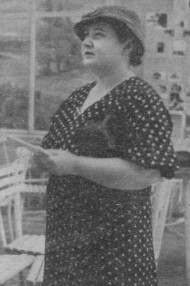
Edward Winter
Despite the continuing stream of new, or purportedly new, chess books, the lover of the game’s lore does not have strong grounds for satisfaction. Our article Historical Havoc discussed the standard of research and of overall accuracy, an issue which may thus be left aside here. Instead, the focus will be on the actual subject matter of books, drawing attention to some of the many gaps existing in English-language literature. In other words, various areas will be indicated where future authors might well make a genuine contribution to chess knowledge. Indeed, unless an author attempts to provide something fresh there would seem no point in setting pen to paper, or finger to keyboard, but that is evidently not the view of all. Some hyper-active authors give the impression of writing books (or even of just phoning them in) not to make a contribution to the game but merely to add to their already absurd personal tally.
To begin at the summit of chess lore, there currently exists no single volume on the general history of chess which can be regarded as wholly recommendable (i.e. for being authoritative and readable). H.J.R. Murray’s 1913 work A History of Chess more or less breaks off when personalities increasingly emerged (in the nineteenth century), and much of it has, in any case, proven indigestible. On page 189 of The Kings of Chess W.R. Hartston called it ‘900 pages of meticulous research, practically unreadable’. In his 1977 Encyclopedia Harry Golombek observed, less comprehensibly, that it ‘suffers, however, from the lack of a sense of history’. Murray’s posthumous book A Short History of Chess (which had additional chapters by Golombek and Goulding Brown) is too short to be regarded as a ‘standard’ volume on the subject, quite apart from being out of date. Henry A. Davidson’s A Short History of Chess is nearly twice as long but insufficiently documented and, in any case, it was published back in 1949. Two more recent forays, Golombek’s A History of Chess (1976) and Eales’ Chess The History of a Game (1985) certainly had their strengths but neither seemed to come fully to grips with the complexity of the subject. In passing, a curious dispute between the two latter works may be mentioned here. On page 495 of the November 1985 BCM Batsford apologized (more or less) to Golombek for claiming that its Eales book was the first such work of historical research since Murray’s 1913 volume. Be that as it may, number one on the wanted list today has to be a, or the, history of chess.
[When the Eales volume was the subject of an expensively priced, though cheaply produced, reprint (Glasgow, 2002) the offending claim in the Batsford edition was nonetheless repeated in the back-cover blurb.]
As regards monographs on individual players, the past decade or so has seen considerable advances (‘strides’ would be an exaggeration) in the production of games collections/biographies, with books on, among others, Pillsbury, Rubinstein, Schlechter and Zukertort. Those players, it will be noted, belong to the ‘silver dozen’ league, and it is almost as if the fallacy prevails that the world champions, for their part, have been properly handled and that it is time to move on to the second division. In fact, the McFarland work on Alekhine by Skinner and Verhoeven is one of the few recent titles to demonstrate industrious research into the career of a world champion, and even that book does not claim to be a formal biography of Alekhine (which is another addition to the wanted list). A number of title-holders (such as Euwe) are yet to be the subject of a complete monograph, covering their full careers. [An English-language volume on Euwe by Alexander Münninghoff was subsequently published, i.e. in 2001.] Steinitz and Lasker also remain to be ‘done’ in terms of good annotated games collections. The two basic anthologies on Capablanca’s games (by Reinfeld and Golombek) were written in the 1940s and are far from adequate today in view of all that is now known about the Cuban. The conclusion, therefore, is that no pre-Second World War champion is currently the subject of a fully-blown annotated games collection/biography worthy of taking us into the new millennium.
C.N. 2207 [see page 207 of A Chess Omnibus] listed a number of other players who merit being the subject of an up-to-date games collection. It could, of course, be prolonged, going back to Philidor, forward to Menchik and beyond. As things stand, these players are seldom represented in print by more than a handful of their best games. For instance, in the case of Menchik it is the same three or four that constantly turn up.

Vera Menchik
On the subject of present-day masters, Kasparov seems, remarkably enough, to be a less popular subject for books than he was in the 1980s. His own book production has also more or less stopped, and anyone who recalls the quality of, for instance, his 1986 work The Test of Time will hope for a return. [Subsequently, in 2000, a fine book was published: Kasparov Against the World by G. Kasparov with D. King. Then came the Predecessors series.] A compilation of all his games, whether annotated or not, must surely appear sooner or later, and it is curious that no writer has yet undertaken this task.
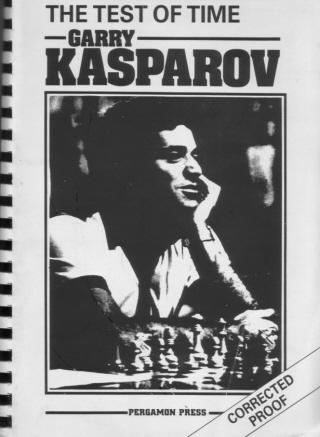
A rare copy (bound) of the proofs of The Test of Time
It would also be pleasant to see more games collections grouped around an identifying theme, and here the possibilities are endless: the Berlin Pleiades, world championship challengers, female players, prodigies, players who died young, players who remained strong in old age, etc. etc. Authors need be restricted only by their imagination and research capacity, but to resort to that cliché is immediately to identify two evident stumbling-blocks.
Here is not the place for an extended grumble about what the chess public is given instead, i.e. a thicket of openings books. It might have been hoped that the development of digital technology, as well as the sheer amount of chess played nowadays, would have reduced the need for openings monographs in paper form, but so far there have been few signs of this. Indeed, databases make it easier for games with a common opening to be scooped together, without, of course, the need to bother about any relevant scores of yesteryear which are absent from those databases, quite apart from concern about articles on those same openings in old periodicals. Until the day we too ‘cease publication’ we shall never fully understand why so many chess writers (and, it must be assumed, so many book buyers) are primarily interested in books on individual chess openings. Is the chess public as a whole really more inspired by a book on the Semi-Slav Defence than by a comprehensive guide to Euwe’s career or, even, Kasparov’s? In a sane world, wouldn’t at least some of the works proposed in the present article be viewed as mainstream chess literature, with openings monographs regarded as of merely minority, and ephemeral, interest?
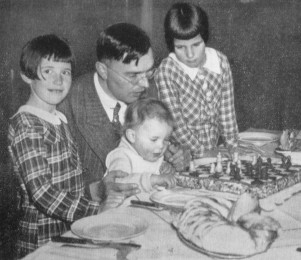
Max Euwe with his children
Anyone aware of the treasures contained in old magazines will find it strange – lamentable, even – that so few of the highlights therefrom are currently available. Tartakower wrote countless sets of fine annotations (in, for example L’Echiquier in the 1930s); many of those notes to his own games were more detailed than the ones that subsequently appeared in his two-volume collection My Best Games of Chess (available as a Dover reprint, though only in the descriptive notation, of course). Another case in point relates to Steinitz. It is often mentioned that he laid the groundwork for his new principles of chess play in his column in The Field, and he was in any case a brilliant annotator. But how many people have ever had the opportunity to read such material? A small monograph bringing together those annotations would be a significant contribution to chess literature. Lasker too was a prolific journalist; if his output was more florid and, probably, of less historical significance, that is no reason to leave it in oblivion. Those who believe that virtually everything written by the great champions of the past is worthy of being preserved can only regret that so little preservation work has yet been undertaken.
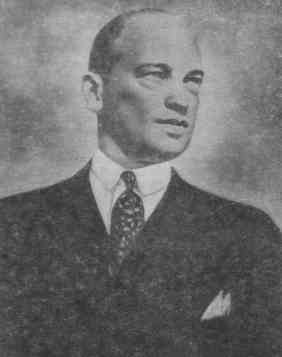
Savielly Tartakower
In the past couple of decades there has been an upsurge in reprints of old books. Edition Olms of Zurich is one of the frontrunners in this field (although it has concentrated mainly on German works). Of late, Eastern European countries have become particularly active, even if Olms’ fine production standards have been impossible to match. Here chess literature has come a long way. Until about 15 years ago, Steinitz’s The International Chess Magazine (1885-1891) was extremely scarce. Since then it has been reprinted by two publishers, helping new generations to understand why it is such a strong candidate for the title of the best chess magazine ever published. Gaps in the ‘reproduction sector’ still remain, though, one being Fiske’s mid-nineteenth-century magazine The Chess Monthly. [It was subsequently reprinted in five volumes by Publishing House, Moravian Chess.] With Dover’s reprints inevitably becoming less popular as the descriptive notation more or less dies out, it must be hoped that publishers will step up the production of algebraic editions of, at least, the classics. There are dozens of books available on the Sicilian Defence, but anybody wishing to read Alekhine’s two complete volumes of My Best Games in the algebraic notation cannot do so.
A substantial list could be drawn up of books for which English translations are sorely needed. Examples are Alekhine’s books on New York, 1927 and Zurich, 1934 ; V. Soultanbéieff’s Le maître de l’attaque, M. Vidmar’s Goldene Schachzeiten (the memoirs of a fine, neglected player) and, to quote a more recent title, David Yanovsky, the Russian book on Janowsky, produced in 1987 by S.B. Voronkov and D.G. Plisetsky. The list could be extended almost indefinitely. A small book by Réti has appeared in Spanish (Curso científico de ajedrez) and in French (Cours scientifique d’échecs), but not in English. And what is on offer to English-language readers interested in Maróczy, who so nearly became a world championship challenger?
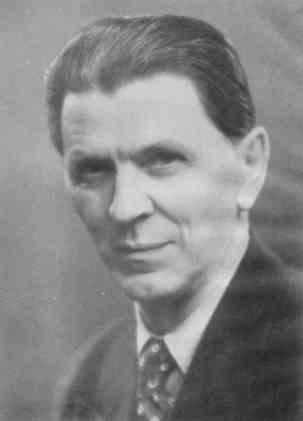
Géza Maróczy
It may be noted too that relatively obscure gaps are being filled whilst gaping holes are left open. Some books offer very detailed treatment of one aspect of chess play, examples being Lasker’s Combination (the double bishop sacrifice) and Middlegame Strategy With the Carlsbad Pawn Structure. That is said not to decry these or other such books, but merely to draw attention to the imbalance that exists in chess literature as a whole.
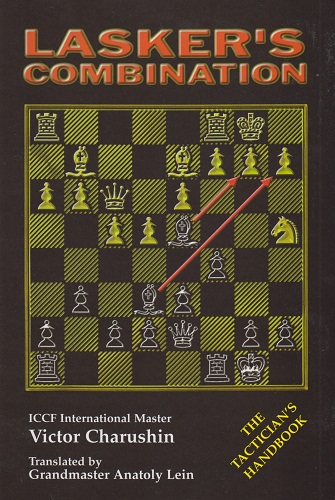
As regards chess archives, it is worth reiterating the extraordinary lack of basic reference material. Although the bibliographical side of English-language chess books is reliable enough (D. Betts covered 1850-1968 and A. Lusis continued the work with a book on 1969-1988), statistical information on chess results is lamentably incomplete, despite the monumental efforts of Jeremy Gaige. His four-volume set of Chess Tournament Crosstables went only as far as 1930, and nobody, it would seem, has yet ventured to produce a dependable chronological list of all match results between strong masters. As long as something as fundamental as that is lacking in chess literature, it is strange for anyone to believe that the heritage has been adequately chronicled. [In 2004 G. Di Felice brought out Chess Results, 1747-1900, a record not only of tournaments but also of nearly 600 match scores; its failure to indicate precise sources was a striking weakness.]
A particularly chaotic field concerns who said/wrote what. Many authors cannot resist slipping in a casual ‘As Tarrasch remarked …’ or ‘Remember Tartakower’s aphorism …’, without any perceptible idea of where the master might actually have made the comment in question. Our library contains a handful of compilations of chess quotes, but in truth none of them has any real value. Seldom are exact sources given, and an epigram may be attributed to Lasker in one book but to Steinitz in another. It will be a brave author who tackles such a project, but sooner or later the work will need to be done by somebody. At the very least, a significant contribution could be made by authors who were to compile quotations on a particular theme (e.g. technical chess advice) or the sayings of an individual master/authority. That, at least, would be a start.
On what is, no doubt, a more arcane level, the ‘pure historian’ would also welcome some works of dense prose which sifted the evidence of such disputes as the Morphy v Staunton non-match, the conditions of the 1910 Lasker v Schlechter encounter and the Termination of the 1985 world championship match between Karpov and Kasparov. On each of these, numerous articles and other features have been published, providing more than enough factual material and argumentation for a complete book. But where, even in general, is the sound investigative journalism that chess so badly needs, for both historical and contemporary issues?
Instead of using primary sources, many, if not most, authors turn to the most readily available books for material that can be effortlessly taken, pinched and whisked. When the same old stuff just shuffles on from one book to the next, it is evident that chess knowledge does not advance but goes round in circles.
A contribution from John Barr (Merion, PA, USA) on the topic of chess books needed:
‘Most of the histories of modern chess that I have read detail changes in the way the game has been played, tracing new ideas in opening theory, or shifts in emphasis from tactics to strategy. But the forces that influence chess history are not all, and perhaps not even substantially, internal. They are the same forces that affect the history of any human endeavor at any time or place. Changes in chess history reflect changes in the attitudes of those who play it and those attitudes are part of a world beyond the board. I am not asking for yet another psychology of the chess player. I question whether such studies have contributed much to our understanding of the game or its history. Major changes in chess play reflect changes in the way the game is conceived. But even the greatest players seldom reflect on the nature of the game the way artists often worry about the nature of art. The attitudes they bring to the board are for the most part unconscious because they are bound up with the world-view of the time.
The social history of chess begins with the question: What social and cultural forces make the new ideas in chess possible? The points to examine are the points of greatest change: from medieval to modern, from romantic to positional, positional to hypermodern. These breaks closely follow the intellectual climate of their time. Why did the very rules of the game change in the fifteenth and sixteenth centuries in the ways that they did? What changes took place in society that allowed chess to come out of the parlor and into the club and then to cross national boundaries in tournament play? What precedents existed for these changes? It is not surprising that the convoluted intellectual temper of Germany should produce the first theorist of positional play, or that a young, unsettled country should produce a maverick master. But the connections need to be examined and explained. The late nineteenth century was characterized by popular, if undefined, notions of science – define the problem, form hypotheses, draw conclusions. If chess is a science, what type of play follows? Positional? Yes, according to Steinitz, but not according to F.K. Young, the frenetic American chess theorist who explicitly premissed his ideas on the notion that chess play should be scientific. What accounts for the difference? The new science of psychology allowed the notion of playing against the man, not the board, long smoldering beneath the surface, to come to the fore. What circumstances allowed this notion out of the closet? The advent of the Hypermoderns closely follows the social upheaval between the wars. Is it connected to popular notions of psychology?
The answers to many of these questions are, I suspect, close to the surface. Answering them will take us outside chess. How does society view games and sports in general? Is the popularity of chess necessarily connected to major advances in theory or play? Or do changes in how chess is conceived affect its popularity? There are other considerations, political, geographic, and biographical which need to be taken into account. many chess books touch upon these issues, but none approaches it systematically. You couldn’t fully understand the history of Renaissance painting without understanding the political and social circumstances of seventeenth-century Italy. Developments in chess also need this broader perspective.’
(798)
See also C.N. 2207 on page 207 of A Chess Omnibus.
On the subject of desirable translations into English, see too C.N.s 1333 (pages 16-17 of Chess Explorations), 6803, 8520 and 11539.
To the Chess Notes main page.
To the Archives for other feature articles.
Copyright: Edward Winter. All rights reserved.